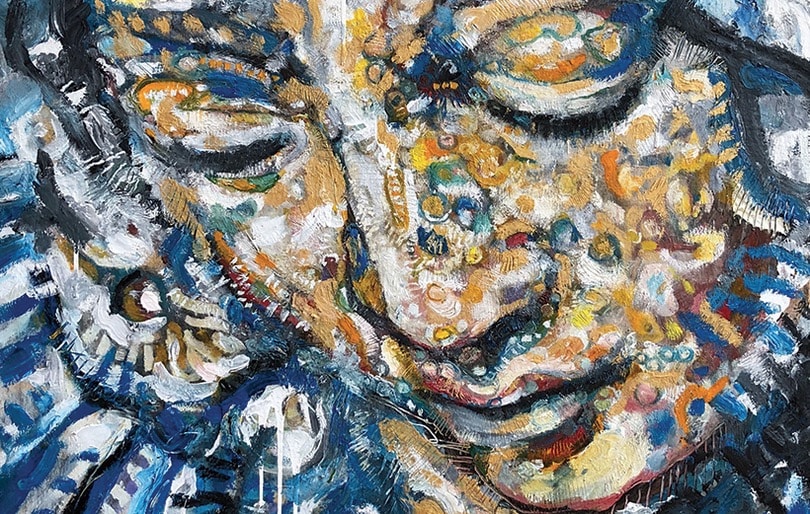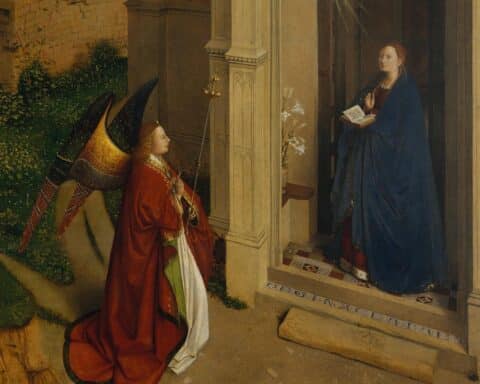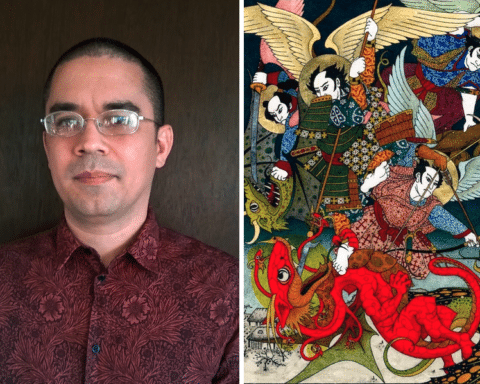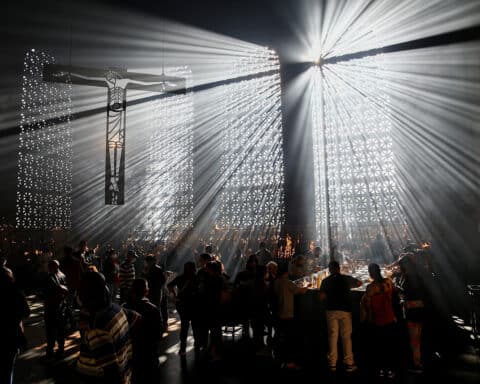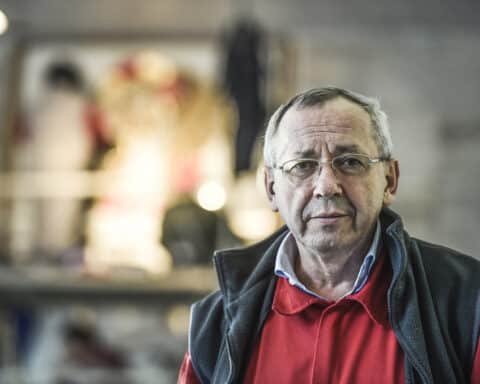The prodigal son in the painting wears a denim shirt with an American flag on the back. His gray-haired father embracing him is in a plaid flannel shirt.
In a digital photograph, a 21st-century Syrian martyr in an orange prison jumpsuit kneels and clutches a palm branch. Hands reach through his halo, holding a knife to his throat.
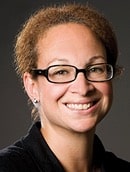
Another work of art, “Christ Pantocrator Triptych,” is in the style of traditional sacred art of the old world masters. There are also sculptures, bas-relief metal, a modern Joan of Arc and art that looks like it was created centuries ago.
“There is an extraordinary variety,” Elizabeth Lev, an American-born art historian who lives and works in Rome, said about the 44 pieces that she selected for the Seventh Juried Catholic Arts Exhibition at Saint Vincent College and Archabbey in Latrobe, Pennsylvania.
The show was to open on Oct. 28, when the winners were to be announced, and it runs through Dec. 2.
Fresh interpretations
The exhibit is inspired by the vision of the late Benedictine Brother Nathan Cochran, who organized the college’s first sacred arts show in 2001.
“It was his idea to revive the Catholic arts,” said gallery assistant director Jordan Hainsey, a Saint Vincent College graduate who worked with Brother Cochran from 2010 until his death in July 2014. He’s currently in the seminary and will be ordained as a priest for the Diocese of Covington, Kentucky.
“He wanted a show that was authentically Catholic, one that extended beyond geographic borders,” Hainsey said of the religious brother.
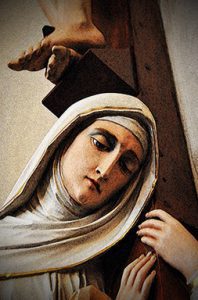
Brother Cochran often said that churches and other sacred spaces should not have reproduction prints ordered from a catalog. He wanted opportunities for contemporary artists to create fresh interpretations of Scripture, the lives of the saints, and other original sacred art that was suitable for liturgical use and public or private devotion.
The exhibitions are now held every two years, and participation has grown in number and distance. This year, 311 entries were received from all over the United States plus Canada, Switzerland, Malta and Italy.
Lev, this year’s juror, teaches at the Italian campus of Duquesne University of Pittsburgh, Pennsylvania, and is on staff at the Pontifical University of the Angelicum in Rome and at Christendom College. She has published numerous articles for art and religion magazines, has written three books (most recently “How Catholic Art Saved the Faith”) and is a popular speaker. She was the host of “Catholic Canvas,” a 10-part television series that aired on EWTN.
“Selecting the works for the exhibit was a bit like being a kid in a candy store,” she told Our Sunday Visitor. “I was struck by the many different media, different themes and different styles. Important recurring themes were fatherhood and sacrifice, and there was a remarkable amount of exquisite craftsmanship whether with paintbrush, pencil or other media. The entries favored clarity — images that were easy to understand and distinguish. Some challenged my own ideas of what art should be and won me over.”
Modern expression, forms
Brother Cochran didn’t want recreation of art from the Renaissance, Hainsey noted. He wanted artists who engaged the Church here and now.
“In this year’s show in particular, we really see an engagement with contemporary events in the life of the Church,” he said. “In past shows we saw emphasis on more of the Gospel narrative. Now artists are picking up these events and figures in the life of the Church today.”
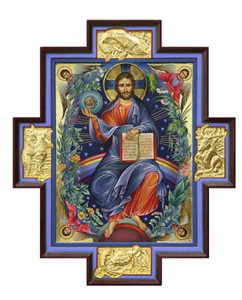
Hainsey’s digital photo in the show depicts “The Coptic Martyrs of Libya,” a group of Egyptian Christians who in February 2015 were kidnapped by Muslim terrorists and beheaded.
Neilson Carlin of Kennett Square, Pennsylvania, painted a moving portrait of another martyr, Father Jaques Hamel, an 85-year-old French priest who in July 2016 was murdered by two Islamic terrorists when he was serving Mass.
“He is lifting the host at the altar, his arms are full of white roses for purity and red roses for martyrdom, and there’s a knife at his throat,” Hainsey said. “It’s a very timely piece that speaks to the fact that the martyrdom of Christians is very much present with us in the Church today.”
Many artists have given contemporary and cultural expression to their work, like “Return,” a modern prodigal son and his father by Eric L. Bjorlin of Minnesota. Others present Jesus as black. Janet McKenzie of Vermont, who was a juror in a previous exhibit, is known for using African American women as models for Jesus. Her “Mother Mary with the Stolen Chibok Girls” represents the more than 250 Nigerian girls who were kidnapped in 2014.
Reclaiming sacred art
Andrew Julo is the curator of the exhibit and of the 4,000 pieces of art in the college and archabbey permanent collections. That includes pre-Columbian artifacts and contemporary pieces purchased from the exhibits. Saint Vincent founder Boniface Wimmer, O.S.B., started the collection in the mid-1800s when his benefactor King Ludwig I of Bavaria sent works from as early as the 16th century.
“Art has been a priority here, and what attracts me about this exhibit is the great diversity from Renaissance and Medieval styles to pieces that really respond to contemporary concerns,” Julo said. “Like Jordan’s digital print — it’s a method of using the technology of today that artists did not have available to them in previous times, and of speaking to what’s happening today and that has happened since the beginning of the Christian story.”
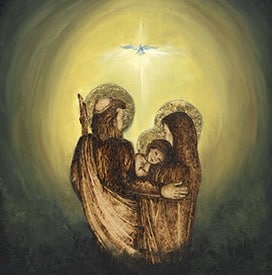
There was a time in the 20th century, Lev said, when Catholic art followed the leads of secular art “using abstract forms and often intentional uncomeliness.” That left the faithful marooned without the beauty of proclaiming the Incarnation through the beauty of art, she noted.
“Brother Nathan’s vision of reigniting the Catholic tradition of beauty by encouraging artists and galvanizing the faithful to look at and think about art is a very important step in the process of regaining art as an effective means of Catholic communication,” Lev said. “This exhibition features a number of works that would be appropriate for the home where people can live daily with religious imagery and share it with friends and family. This is a crucial part of reclaiming sacred art from the sterile environment of museums and returning it to everyday life.”

